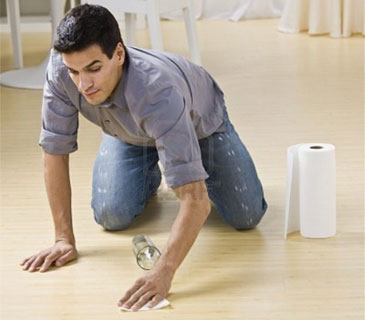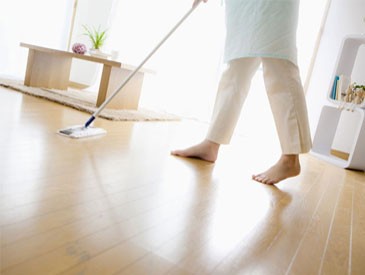Cleaning Tips

Soap and water, polish, wax or what? Take the guesswork out of how to clean hardwood floors and go from dull and grimy to gleaming and gorgeous in a few easy steps.
First Things First—Determine the Finish
Before you grab a bucket of water and a mop, it's best to find out how your hardwood floor is sealed—if at all. Why? The finish, not the wood type, determines how you clean and care for the floor.
Surface-sealed floors: Most new wood floors are sealed with urethane, polyurethane or polyacrylic. Surface-sealed floors are stain and water-damage resistant and easiest to care for and clean: Sweep, mop and you're done!
Penetrating-seal-treated and oil-treated floors: Also common, a penetrating seal or oil finish soaks into the wood grain and hardens. This type of floor must be pampered and protected with liquid or paste wax.
Lacquered, varnished, shellacked and untreated floors: Although technically surface finishes, lacquers, varnishes and shellacs are not as resistant to moisture, spills and wear as the other sealants mentioned. Treat floors with these finishes and floors with no finish as you would penetrating-seal-treated and oil-treated floors.
Not sure what kind of finish you have? To tell the difference in a pinch, just rub your finger across the floor. If no smudge appears, the floor is surface sealed. If you do create a smudge, the floor has been treated with a penetrating seal, oil finish, shellac, varnish or lacquer, and then waxed.
Cleaning Surface-Sealed Floors
Product Do's and Don'ts
Don't use oils, waxes or furniture sprays. Oil leaves a residue, furniture spray creates a slippery surface (think ice-skating rink!) and wax takes time to apply and makes recoating (see Tackling Simple Wood Floor Problems) difficult.
Don't use straight ammonia, alkaline products or abrasive cleaners. They'll dull or scratch the finish.
Do use a floor-cleaning product recommended by the floor finisher or opt for plain soap and water. If the recommended product is hard to find or costly, and other floor cleaners contain ingredients that violate your floor's warranty, try soap and water. I add a quarter cup of mild or pH-neutral soap (like liquid dishwashing soap) or Murphy Oil Soap (despite the name, it doesn't contain oil) to a bucket of water.
Don't rely on water alone or a vinegar and water solution to clean hardwood floors. Mopping with water will result in dingy-looking floors and won't-budge dirt buildup. Vinegar and water is not as effective as soapy water and—some suggest—may dull floors sooner. (Eventual dullness and the need to recoat are inevitable no matter what you use. See Tackling Simple Wood Floor Problems.)
Routine Cleaning
In high-traffic areas, like the dining room and kitchen, you should sweep daily, if possible, and mop once or twice a week. Mop less-trafficked areas once a month or once a season.

Mopping Technique
- Remember: Water is wood's worst enemy (even on sealed floors!), so use a damp mop rather than a soaking wet one.
- Dip the mop into the bucket of prepared cleaning solution, wring it out completely, mop in the direction of the wood grain and repeat. When the water gets dirty, empty the bucket, mix a new batch of cleaning solution and continue mopping.
- When finished, go back over the entire surface with clean water to rinse.
- Don't be afraid to get on your hands and knees if necessary. When a floor needs serious attention, I clean it with a cloth. (It's better than a sponge because you can "feel" the dirt as you wipe!)
Tackling Simple Wood Floor Problems
- Scuff marks getting you down? A bit of baking soda on a damp sponge will erase them.
- Noticed a stubborn food, water or grease stain on your surface-sealed floor? Always use a commercial cleaner to treat this problem.
- Hairline cracks in the floor? Don't panic and attempt to fill them. Dry heat during the winter months causes wood floors to shrink and crack. Cracks should close up during the summer (though using a humidifier can also help).
- Finish looking dull? Sand the floor lightly and recoat with an additional layer or two. Recoating is necessary about every five to seven years.
Cleaning Tips
- Hard floors are becoming more popular as people are starting to focus on a healthy home. Keep reading to find out how to care for your hard floors properly.
- Clean your hard floors at least once a week using a sweeper, a dust/dry mop, or a hard floor cleaner and wood floor cleaner. By sticking to this routine, abrasive materials will not be able to collect on the surface, and your floors should keep a shine much longer.
- Doormats should be placed at every entrance of your home. This will keep sand, grit and dirt from being tracked into the home. These are very abrasive materials, and can scratch and ruin hard floor surfaces.
- One of the major benefits of hard floors is allergens do not get trapped as they do in carpet. Cleaning hard floors regularly will lead to a healthier home.
- When spills occur, clean them up immediately. This will keep substances from staining the floor or grout, and will save you the trouble of having to remove a stain from your floor later on. Clean spills on hard floors using a damp towel and warm water, or if necessary a cleaning solution made specifically for your type of floor. Never use abrasive cleaners on your hard floor.
- Avoid dragging heavy furniture across your hard floor as this can cause scratches. If you can’t elevate the entire piece of furniture, use a soft glide underneath the furniture to allow it to move easier.
- Place a rug in front of a sink in rooms that have hard floors. Hard floors can become very slippery when they are wet, and a rug will keep water from forming a puddle on the floor.